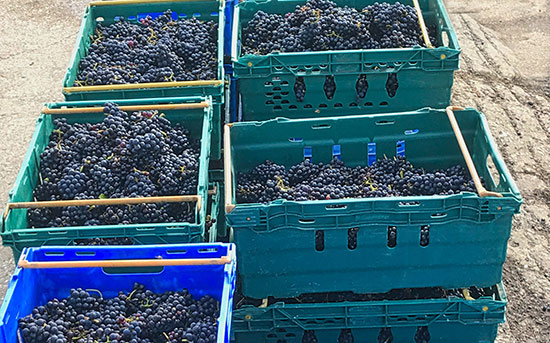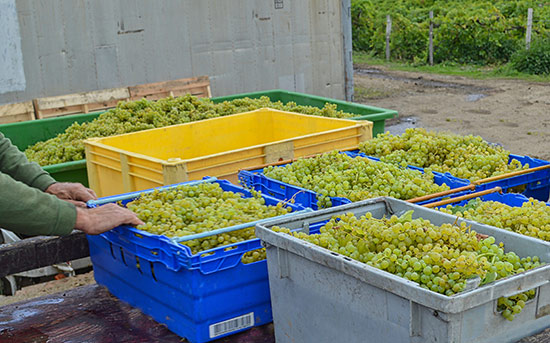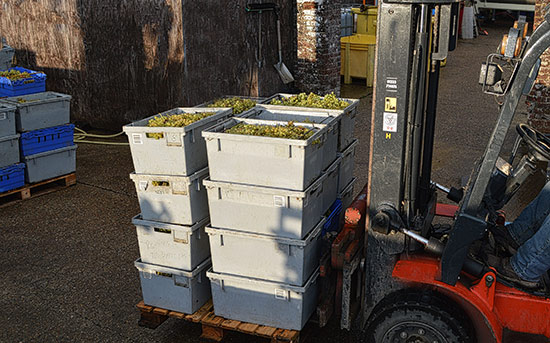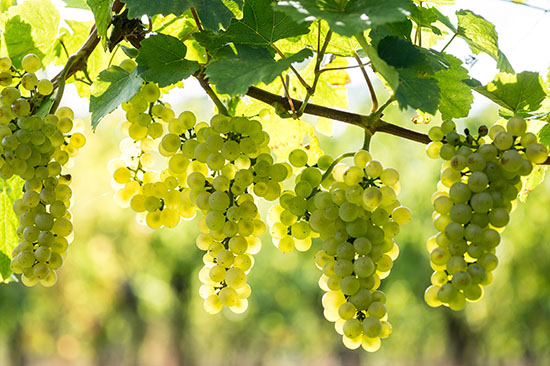The Vineyard
Planted on the gentle slopes of the Sussex Weald in an area of Outstanding Natural Beauty in the heart of 1066 Country.
Climate
Although we are at the northern extreme of vine growing in Europe, a number of factors enable us to grow vines successfully here (without even a mention of climate change).
The UK benefits from the Gulf Stream which brings warmer temperatures than we should have at this northerly latitude. As an island we are surrounded by sea which also helps to maintain and moderate temperatures well into autumn, and the vineyard itself is only five miles from the coast. Our northerly latitude also provides us with longer hours of daylight in summer, and a longer growing season.
Our location in the far south eastern corner of the UK allows us to enjoy some of the warmest and driest conditions in the country. The generally cool climate for vines, long growing season and slow ripening into autumn means that our grapes possess a concentration of delicate aromatic fruit not to be found in more robust wines from warmer climates. As well as producing crisp light wines, the flavours often echo fruits traditionally grown in this area, such as green apple and pear.
Situation
The choice of site is vital for the success of a vineyard. A gently rolling, south-facing slope (which we have here) is the ideal situation, to ensure maximum exposure to any hours of sunshine and to minimise the potentially damaging effects of late spring frosts.
Importantly the altitude is quite low, at about 40 metres above sea level, which also means we profit from warmer temperatures.
The site is well sheltered by the Hastings Ridge to the south which protects us from the strong winds that blow up from the Channel, and is surrounded by hedgerows and trees acting as natural windbreaks. All these factors help in creating a warmer environment for our vineyard.
Soils
The soils are essentially clay loams over a sandstone subsoil of the Hastings beds. The clay component adds good aromatics to the wine whereas the sand aids the free draining of the soil, helping maintain healthy roots.
The roots are thus encouraged to plunge deep down into the soil in search of water and essential nutrients. Within the sandstone, traces of iron ore can be found which has a naturally high mineral content. All of this contributes to the distinctive fruit flavours in our wine.
Trellising
At the moment the majority of our vines are grown on a trellising system called Geneva Double Curtain. This is a high wire training system that brings the vine cropping zone and main trunks up to about 5 feet above the ground. It also allows us to develop a bigger vine plant which absorbs some of the vigour of our fertile soils.
We initally had quite a low planting density at about 450 plants per acre, but the larger plants mean we can still crop at economic yields. However, our recent replantings have been at a much higher density with about 1000 plants per acre to ensure that we can maximise our wine production.
The height of the plants also takes the vulnerable fruiting area away from damaging spring ground frosts. Other advantages of this system are that it is easy to manage, requires a minimal use of mechanisation, and allows all hand work (pruning and picking) to be carried out at eye level rather than the back-breaking knee level of many of the older European vineyards, especially those in the Champagne region.
Varieties
At the time that our vineyard was originally planted, the wine industry in England was still in its infancy. Much research involving vine crossings had been carried out in German viticulture institutes in their search for more reliable fruiting and ripening in the cool climate of Northern Germany, and the UK benefitted from that. However, these relatively ‘new’ varieties were given names unfamiliar and at times unpronounceable to a wary UK wine-drinking public.
About a dozen varieties were initially selected for our vineyard (back in 1971!) and are what we grew for the first 40 years. As our vines have aged and matured it has become obvious that some of our choices were immensely successful, whereas others were less so. During 2009 and 2010 we began the first step in a ten year plan of replanting the vineyard, and grubbed out 8 acres of Schonburger, Huxelrebe, Kerner and Muller-Thurgau replacing them with Bacchus, Pinot Noir and Pinot Blanc.
Winery
The original farm site possessed some old stables and out buildings which lent themselves perfectly to a conversion into a winery. The buildings are over 100 years old and have a very traditional, rustic feel. The winery itself is kitted out with a 2 tonne pneumatic Willmes press, Seitz filtration unit and approximately 25 fermentation and storage tanks. We also have bottling and labelling machinery so that all aspects of wine production through to dressing the finished product are carried out on site.
We keep the handling and movement of the juice and wine down to a minimum to retain the fresh fruit flavours and allow natural clarification through the cold winter months. The new wines are tasted in early spring to determine any further treatment and to evaluate any blending required.
The still wines will be bottled by the end of April and the sparkling wines by the end of May as the weather starts to warm up.
In between the summer work on the vineyard, the fruit wines are also made and bottled. The sparkling wines that are maturing in bottle are tasted regularly to determine the right time for yeast removal or ‘disgorging’, and the disgorging procedure can take place at any time of the year. All the winemaking processes and procedures are carried out on the vineyard estate which gives us much better control over the quality of the final product.


Our Pinot and Bacchus grapes picked and ready for the press.

The grape harvest is collected from our fields by tractor and taken straight to the winery.

The previous year’s harvest is tipped into the press to begin the wine making process.

Our Rose sparkling has been remuaged – lifted on to their tips ready for the disgorging process. The yeast plug is still in the bottle tops ready to be removed.



